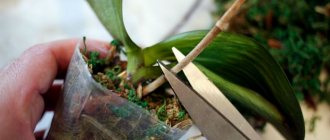The article was prepared by a specialist for informational purposes only. We urge you not to self-medicate. When the first symptoms appear, consult a doctor.
The orchid attracts many gardeners with its beauty. However, this plant is very demanding to care for. If you do not follow certain rules, the orchid may die without ever pleasing its owner with beautiful flowers. Therefore, it is so important to choose the optimal soil for the plant, provide it with sufficient moisture and follow the watering regime.
Care after purchase
When the plant is just brought home, you need to send it to some kind of isolation for at least 2 weeks. Experienced flower growers recommend immediately replanting the flower in new soil to assess the condition of the roots and prevent diseases caused by possible incorrect care in the store.
After transplanting, the flower must be placed in a warm and bright place. The orchid should not be watered for at least four days after transplantation - if you cut the roots, the cuts may fester due to excess water.
So, two weeks passed, the flower took root well and showed no signs of disease. What kind of indoor care should I provide next? The orchid is a capricious flower native to the tropics. The whole essence of care comes down to organizing conditions that are similar in properties to the natural growing environment.
What do you need to know?
Modern stores offer everything you need to create favorable living conditions and long-lasting flowering. It is important to follow the correct care and breeding steps: correct pot, morning watering, spring-summer feeding, rare transplants, temperature and light conditions.
If you were given an orchid in a pot or you bought the plant yourself, it will be important to learn how to care for this rather capricious flower and how to monitor its health. Growing rules depend on the type of flower , on the substrate in which it grows in the store, and also on what it was fed with.
Important : Any type of orchid develops favorably at temperatures from 18 to 27 degrees during the day and 13-24 degrees at night!
Lighting
A wild orchid almost always receives diffused light. In this case, daylight hours last more than 12 hours. Therefore, it is worth choosing a place where there will be enough light, but at the same time not allowing direct sunlight to fall on the leaves.
It is worth taking care in advance to compensate for the insufficient duration of daylight hours: additional illumination with one 40 W light bulb is enough for the flower.
How to properly care for an orchid?
The orchid is rightfully considered a very capricious plant that requires careful and reverent treatment. It requires the creation of suitable conditions. However, you should not be afraid to start a flower, you just need to know the basic rules of caring for the plant.
Correct lighting
The health of the plant and the frequency of flower appearance depend on how well the lighting is chosen. If the orchid gets enough sunlight, it will bloom regularly. The fact that the plant needs additional lighting will be indicated by pale leaves, which will subsequently stretch out and turn yellow.
In order for the orchid to feel as comfortable as possible, you should follow simple rules:
- The flower should not be exposed to direct sunlight. The light must be diffused.
- During the summer months, it is best to use a frosted window film to slightly darken the plant's habitat. This will avoid burning the leaves.
- In autumn, the sun is not so intense, so the film can be removed. Soft rays will not harm the plant, but will contribute to its comfortable transition to a dormant state. At this time, old shoots ripen, and new shoots are formed, which will become flowers in the future.
- A lack of light harms an orchid no less than its excess. For normal flower growth, daylight hours must last at least 12 hours. Therefore, in winter it is necessary to provide the plant with artificial lighting. To do this, you can use a lamp with fluorescent lamps.
Selecting the optimal temperature regime for an orchid
The temperature regime must be selected depending on the type of orchid:
- The Lady's slipper orchid, as well as flowers of the genus Dendrobium and Lelia, are cold-loving plants. They grow in countries with a subtropical climate, as well as in the highlands. For such varieties of orchids, the optimal summer temperature is 22 degrees, and the winter temperature is 12-15 °C.
- Orchids of the genus Miltonia and Odontoglossum are plants that prefer average temperature values. They grow in mountainous areas of tropical countries. The optimal daytime temperature for such flowers in the summer months is 18-22 degrees, and in winter –12-15 °C.
- Cattleya orchids, Phalaenopsis and some flowers from the genus Dendrobium are heat-loving plants. Their natural habitat is the forest belt of the coastal tropics and tropical plains. The optimal daily temperature range for these varieties is: 15-32 degrees in summer, 15-18 °C in winter. It is important that daily temperature fluctuations do not exceed the range of 3-5 °C.
Thus, almost all orchids are able to tolerate daytime temperatures of 18-27 °C, and night temperatures of 13-24 degrees.
Watering an orchid
An orchid is a plant that does not tolerate stagnant moisture, so watering should be moderate. However, the watering regime varies for different types of flowers. Thus, orchids of the genus Oncidium and Dendrobium require moisture only after the soil is completely dry. In turn, orchids of the Phalaenopsis and Paphiopedilum varieties prefer moist soil.
In any case, all orchids tolerate drought much better than overwatering. During active growth, during the period of release of peduncles and during the flowering process, they require more moisture. Insufficient moisture supply is indicated by the appearance of wrinkles on the leaves and wrinkling of the pseudobulb. An excess of water is characterized by yellowed and soggy leaves, as well as rotting roots.
In winter, at low temperatures and in low light, there is no need to water the plant at all. The orchid's moisture should be very moderate during the period after flowering, as well as during the resting stage.
The water used to water the flower must be soft. It is good if it is possible to water the plant with melted or settled rainwater. If this is not possible, then you should use ordinary boiled water for irrigation.
In the summer months, the need to moisten the soil will be indicated by a dry soil surface. As a rule, 2-3 waterings per week are enough for the orchid to feel comfortable. You should also pay attention to the pseudobulb. If it wrinkles and decreases in size, then the flower needs additional moisture.
It is equally important to water the orchid correctly. To do this, you need to place it directly in the pot in a bowl filled with warm water. The holding time is 10 minutes. You can use the shower, watering the plant from above. In the latter case, it is important to allow excess moisture to drain. To do this, place the pot on a wire rack so that the water drains out through the drainage holes. Only after this can the flower be returned to the decorative pot.
Feeding and fertilizing
Fertilizers should be applied no more than once every 14-21 days. This should be done only when the orchid is in the active growth phase. You can use fertilizers such as Bona Forte, Pocon, Greenworld. You should not add a larger dose of fertilizer to the pot than indicated on the package.
Flowers do not tolerate mineral salts well, and their excessive concentration can lead to the death of the plant. Therefore, it is so important to wash the soil with running water once a week. You can alternate fertilization with flushing: 1 week - watering, 1 week - fertilizing.
You should not use fertilizers that are intended for other plants to feed orchids. There is no need to apply them in winter and during the dormant period.
Most gardeners believe that frequent feeding of an orchid only harms the plant. This negatively affects the state of its natural immunity, as a result of which the flower begins to suffer more often from various diseases.
You can avoid applying fertilizers altogether if you follow the periodicity of soil renewal. In order for the plant to receive all the nutrients from it, the soil must be changed at least once every two years.
Temperature
In general, an orchid feels quite comfortable when indoors. The main thing is not to harm the flower with a random draft or air currents from the air conditioner: the orchid does not like cold air currents.
What should healthy orchid roots look like?
Experts believe that the root system of an orchid should not be any one specific color. And a change in color does not always indicate diseases of the flower: it can signal some changes in its life.
With any neutral color, healthy roots should have the following qualities:
- elasticity;
- hardness;
- lack of lethargy;
- healthy appearance;
- no visible damage.
Air humidity
The tropical forest is incredibly humid: such conditions cannot be created in an apartment without the use of greenhouse structures. But there is no need for such excesses - it is enough to periodically spray the indoor plant with a spray bottle.
When spraying, you need to irrigate the entire plant, avoiding only the inflorescence. The water must be settled, always at room temperature. It is necessary to spray the orchid 3-4 times a week.
Varieties of orchids for cultivation at home
The furnishings of a city apartment or a private house are great for humans, but not for plants. This becomes especially noticeable with the arrival of cold weather, when the heating is turned on and the air humidity in the room drops sharply.
Such conditions, combined with shortened daylight hours, are extreme for plants, especially delicate tropical ones.
Therefore, not every orchid can be kept at home in the expectation that it will feel great, bloom and smell.
There are relatively few orchids that are suitable for growing indoors, and each of them has its own characteristics. Basically, these are epiphytes (lithophytes), less often terrestrial orchids.
They are divided according to the type of growth into monopodial and sympodial, and according to the temperature regime - into heat-loving and cold-loving. Cold-loving species are distinguished by the fact that they need wintering at low temperatures:
- Monopodial: phalaenopsis;
- Wanda;
- vandopsis;
- brassavola;
- ascocentrum;
- ascocenda;
- Angrecum;
- sarcochilus;
- aerides;
- Doritis;
- vanilla.
Brassavola.
- Sympodial: dendrobium;
- oncidium;
- cymbidium;
- miltonia;
- miltassia;
- Cattleya;
- lelia;
- odontoglossum;
- paphiopedilum;
- phragmipedium, etc.
Phragmipedium.
Orchids are divided into monopodial and sympodial types.
Regularity of watering
Orchid roots are extremely sensitive to both excess and lack of water. Understanding how to water a flower without harming it comes with time.
Most gardeners recommend watering orchids using the immersion method. The roots of the plant are extremely sensitive to humidity levels, and this method is the safest of all possible.
If signs of overwatering appear, then you need to carefully remove the orchid from the pot and remove the rotten parts of the roots. The soil should be replaced, because the old soil will remain excessively wet and the rotting process will start with renewed vigor. Naturally, after therapeutic manipulations, it will be necessary to review the frequency of watering.
If, on the contrary, the flower does not have enough moisture, it will let you know by thinning and yellowing of the leaves, followed by their falling off, starting from the lowest ones.
Diseases and pests
The main factor influencing rotting and death of roots is excessive moisture. But plants are also susceptible to diseases and pest infestation. If improperly cared for, phalaenopsis exhibits the following diseases of the root system:
- Root rot.
- Cervical rot.
- Bacteriosis.
- Gray rot.
Sometimes the roots acquire a brown color, looseness and a putrid odor, and turn black, but why this happens is not clear to the gardener. Often these problems arise due to putrefactive diseases.
The main methods of combating diseases are:
- in pruning infected roots with complete removal of affected areas;
- treating the soil and root system with fungicides (three times at two-week intervals);
- placing the flower in fresh calcined, disinfected soil;
- creating optimal conditions for the development of orchids.
Plant pests:
- Spider mite.
- Mealybug.
- Soil mite - useful in small quantities to control other pests. If it grows excessively, it eats the roots.
- Snails.
- Slugs.
Parasites eat up the roots of plants and they dry out. Snails and slugs are controlled by inspection and pest control.
The following measures are taken against others:
- treatment with acaricides for the soil substrate and root system;
- plant transplantation;
- reduction of humidity, ventilation;
- steaming the substrate;
- reduction of nutrients in the soil.
Soil selection
The right soil is half of successful care. When selecting soil, you need to know exactly the variety of your flower. If you are not sure about the type of plant you have, you can use a photo of the orchid to determine as accurately as possible whether it is a terrestrial or arboreal species.
If the orchid is a terrestrial variety, then additional nutritional supplements will need to be added to the standard orchid soil mixture.
Similar additives can be humus or a mixture of charcoal and peat. But varieties that naturally grow on trees do not need soil with additional nutrients, but they do need soil that will not interfere with the evaporation of excess moisture.
You need to mix into the base soil elements that loosen the soil and increase air circulation in it, for example expanded clay, oak or pine bark, moss or even the husks of ordinary seeds.
The importance of healthy roots for a plant
Orchid roots always raise many questions for novice plant growers, due to the structural features of this part of the plant. Understanding the needs of this organ will help to grow the bush in comfortable conditions, encouraging it to bloom abundantly. Monitoring the root system will help to identify possible diseases and other problems in a timely manner.
Did you know? Not all orchids live in the tropics - some of their species can also be found in Russia. The widely known lady's slipper, night violet, and orchis are representatives of the orchid family.
To get an idea of how the root system works, you need to know that orchids in nature do not grow in the ground, but wrap their roots around stones, plants or other natural objects. They receive moisture from the air and atmospheric phenomena (rain, fog, dew), and nutrients not from the soil, but from leaves, pieces of bark, wood dust, animal excrement and insects falling on them.
Fertilizing
For successful development, the flower must receive soluble mineral fertilizers containing phosphorus, nitrogen and iron.
It is worth purchasing a complex balanced fertilizer and applying it according to the manufacturer’s instructions.
Reproduction
Orchids reproduce both by seeds and through the separation of shoots. Growing at home from seeds is a labor-intensive process, almost impossible for an inexperienced gardener.
The fact is that orchid seeds do not contain nutrients due to their structural features, and therefore they germinate successfully only on a sterile nutrient medium.
A much more common method is to grow “babies” - young plants formed either on a peduncle, on a stem, or at the root. When a shoot is formed, it is necessary to add an additional portion of nitrogen fertilizers for the comfortable development of both the baby and the mother plant.
It is necessary to move the baby into adulthood after the formation of 2-3 leaves and at least a pair of horses at least 5 cm long. You need to separate the shoot with a sharp knife, after which the cut needs to be treated with charcoal to prevent rotting.
The separated shoot is planted in a pot; at first, a fine substrate should be used as soil. Caring for a young orchid is generally similar to caring for an adult plant. Flowering should not be expected until the second year of life, depending on the variety.
How to care for an orchid during the flowering phase and after it?
If the plant has formed flowers, then the following care recommendations must be followed:
- It is necessary to water the orchid intensively. The best way to do this is with a shower. The water should be warm. The optimal temperature is 35 °C. It is important that water does not remain at the growing point of the orchid, as this threatens the death of the plant.
- The temperature at night should not be too low. It should be increased by 5 °C from the recommended one.
- It is forbidden to replant the plant during the flowering period.
- During the flowering phase, fertilizing can be applied, but moderation should be observed.
You should not often move the orchid from one place to another, this will increase the flowering period.
Caring for an orchid during the dormant period
After the flower has become dry and blackened, it is necessary to cut it off. The cut must be made at the very base. Feeding during the dormant period should be abandoned or reduced to a minimum. In winter, the orchid is watered once a month, but you can spray the plant more often.
If an orchid does not bloom at the appropriate time, this indicates that it needs to be replanted. You can try moving the pot to another place - this should help. It is also necessary to transfer a flower when its leaves wrinkle and turn yellow, and the peduncle does not appear.
Proper care of such a fastidious plant as an orchid will ensure its regular and long-lasting flowering.
Transfer
The orchid needs to be replanted every 2 years. A complete change of soil and an increase in the volume of the pot are required.
Fresh soil is moistened in advance, the flower is transferred to a new pot, after which the plant must be left for three days in a place with a minimum of sunny color for comfortable adaptation. These three days the plant does not need to be watered.
How to distinguish living roots from dead ones?
Even experienced gardeners cannot always distinguish a living root from a dead one, which does not provide any benefit to the plant; it can simply be removed. You can tell the difference using water. To do this, the plant is placed in water for a long time, and then the changes that occur are observed. Roots that are bright green in color and have an elastic structure are alive and can function normally. If the shoots in the water remain pale gray in color and do not change their structure, then they are dead and cannot benefit the plant; such elements must be gotten rid of by pruning. Also, the velamen has many breaks on dead roots, which also indicates the incapacity of the shoots.
Yellowing leaves
The gradual death of the lower leaf is considered natural. If several leaves of a plant begin to turn yellow at the same time, this should be taken as an alarming signal.
First of all, inspect the plant for the presence of pests, and if none are found, then consider watering and feeding the orchid: most likely, it does not have enough nutrition.
What happens to a flower if it is transplanted?
Experts say that replanting an orchid is stressful . It is quite natural that the plant will be sick at first, and the growth of the root system and leaves is also possible. And the gardener’s task is to make this period easier for the flower.
Important : The best time to transplant an orchid is spring, since it is in spring that the roots and leaves of the plant begin to gain strength and grow vigorously.
It is at this time of year that the adaptation period of the flower to the new pot and substrate will be most successful (read more about choosing a pot and soil here). But you should not perform any manipulations with the orchid during flowering: it can shed all the flowers and buds. Such measures should be resorted to in extreme cases, when the entire plant is in danger of death.
Read more about whether it is possible to transplant a beauty when it has released an arrow, read here.
Lack of flowers
It is worth understanding that a completely healthy plant will definitely bloom. Most often, adding abundant fertilizing during the growing season and changing lighting conditions helps.
First of all, try to increase the length of daylight hours - orchid flowers are even worth the additional costs of creating artificial lighting.
Conditions of keeping and breeding
Orchids require different care than houseplants . There are several distinguishing criteria.
- Transparent pot. It is easier to control the condition of the root system, whether it is rotting. A healthy plant has light green or pearl colored roots.
- Special substrate. The plant grows in a special substrate consisting of several components:
- bark;
- sphagnum moss;
- peat;
- Styrofoam;
- expanded clay
- For irrigation, soft, melt or rain water, boiled or settled, is required. Do not water the orchid with running water.
- For proper growth and development of an orchid, moisture and regular spraying are necessary.
Read more about the conditions for keeping orchids here.
Fungi and rot
Due to excessive watering, rot or fungi sometimes appear. To get rid of them, it is necessary to cut off all affected areas as quickly as possible and treat the sections with a fungicide.
With the correct selection of growing conditions, all regular care will consist of timely watering. Understanding the right moment for watering comes with experience, and following other simple rules of care at home allows you to admire abundant flowering.
Is it possible to trim air shoots and how to do it: step-by-step instructions
If diseased and dying roots are detected, measures are taken to trim them:
- Wash with warm running water.
- A sharp knife is disinfected with a non-alcohol composition.
- Trim dry, spotted, brown, blackened roots. A yellow or light brown color with good turgor indicates a lack of lighting, but not the health of the roots.
- Sections are disinfected:
- ground cinnamon;
- activated carbon;
- other alcohol-free antiseptics.
- Allow time for the sections to dry.
- The roots are treated with a drug to combat fungal diseases.











